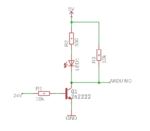jelezarov
Member level 1

Hi,
like the title says, my aim is to detect on/off states on a 24V input with a microcontroller (arduino). A pretty common problem, for the looks of it, but none of the found solutions meets all of the following criteria:
- the input may vary to some degree (22-30V);
- ideally no heat generation, no 1-2W resistors;
- as small and with little parts as possible;
- and it has to have a LED
So I came up with this:

On a breadboard this seems to work so far, but I wanted to show it here, because most of you are lot more experienced than I am. So, can something be improved in my circuit, considering the above expectations ?
Cheers
like the title says, my aim is to detect on/off states on a 24V input with a microcontroller (arduino). A pretty common problem, for the looks of it, but none of the found solutions meets all of the following criteria:
- the input may vary to some degree (22-30V);
- ideally no heat generation, no 1-2W resistors;
- as small and with little parts as possible;
- and it has to have a LED
So I came up with this:

On a breadboard this seems to work so far, but I wanted to show it here, because most of you are lot more experienced than I am. So, can something be improved in my circuit, considering the above expectations ?
Cheers




